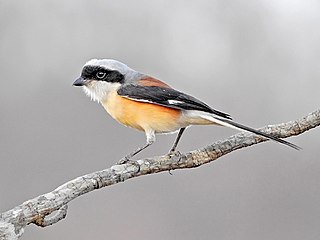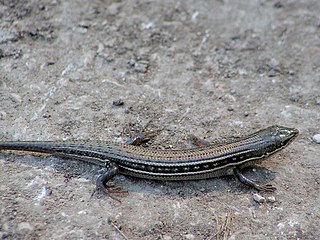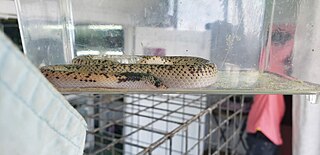
The bay-backed shrike is a member of the bird family Laniidae, the shrikes, resident in South Asia.

The brown basilisk, also commonly referred to as the striped basilisk or in some areas as the common basilisk, is a species of basilisk lizard in the family Corytophanidae. The species is native to Mexico, Central America and adjacent northwestern Colombia, and has been introduced into the U.S. state of Florida as a feral species. The brown basilisk has large hind feet with narrow flaps of skin on the distal edge of each toe. The fact that they move quickly across the water gives them the appearance of "walking on water".
Erythrolamprus ocellatus, commonly known as the Tobago false coral snake, red snake, or doctor snake is a species of colubrid snake, which is endemic to the island of Tobago.

The striped keelback is a species of colubrid snake native to Indonesia. It has also been introduced to Singapore and Puerto Rico.

The bridled mabuya or bridled skink is a species of skinks found in North Africa and Middle East. The length of those skinks is up to 22 cm.
Alsodes vittatus is a species of frog in the family Alsodidae. It is endemic to Chile and only known from its type locality, San Ignacio de Pemehue, Malleco Province. It may be threatened by habitat loss through pine plantations and it is not known from any protected areas. It has not been seen since its discovery and searches in 1995, 1996 and 2002 failed to find it.
Boophis vittatus is a species of frogs in the family Mantellidae.
Scolecomorphus vittatus, the banded caecilian, is a species of caecilian in the family Scolecomorphidae, endemic to Tanzania. Its natural habitats are subtropical or tropical moist lowland forests, subtropical or tropical moist montane forests, plantations, rural gardens, and heavily degraded former forests.

The laced woodpecker is a species of bird in the family Picidae.

The greater broad-nosed bat is a species of bat in the family Phyllostomidae. It is found in Bolivia, Colombia, Costa Rica, Ecuador, Panama, Peru, and Venezuela.

Crotalus stejnegeri, commonly known as the Sinaloan long-tailed rattlesnake or just long-tailed rattlesnake, is a venomous pit viper species in the family Viperidae. The species is native to western Mexico. There are no recognized subspecies.

Atractus is a genus of colubrid ground snakes in the subfamily Dipsadinae. The genus includes more than 140 distinct species.

Diplodactylus vittatus, commonly known as the eastern stone gecko, stone gecko, and wood gecko, is a species of diplodactylid lizards that occurs in forest, shrubland and arid regions across Australia. It is widespread across the states of Queensland, Victoria and New South Wales, commonly found in dry peripheral bushlands. This gecko can be kept as a pet or seen within zoo enclosures.
Phimophis is a genus of snakes in the subfamily Dipsadinae. The genus is endemic to South America.
Rodriguesophis is a genus of snakes in the family Colubridae. The genus contains three species, all of which are endemic to Brazil.

Wiegmann's striped gecko is a species of lizard in the Sphaerodactylidae family native to northern South America.

Phimophis guianensis, also known commonly as Troschel's pampas snake, is a species of snake in the subfamily Dipsadinae of the family Colubridae. The species is endemic to South America.

Phimophis guerini, the Argentine pampas snake, is a species of colubrid snake in the subfamily Dipsadinae. It is endemic to South America.
Atractus vittatus is a species of snake in the family Colubridae. The species can be found in Venezuela.

Conophis vittatus, the striped road guarder, is a species of snake in the family Colubridae. The species is native to Mexico and Guatemala.













